Morphotectonic Structures along the Southwestern Margin of Lesvos Island, and Their Interrelation with the Southern Strand of the North Anatolian Fault, Aegean Sea, Greece
Abstract
:1. Introduction
2. Materials and Methods
3. Results
3.1. Swath Bathymetry
3.2. Morphological Slope Analysis
3.3. Morphotectonic Structure
4. Discussion
5. Conclusions
Author Contributions
Funding
Institutional Review Board Statement
Informed Consent Statement
Acknowledgments
Conflicts of Interest
References
- McClusky, S.; Balassanian, S.; Barka, A.; Demir, C.; Ergintav, S.; Georgiev, I.; Veis, G. Global Positioning System constraints on plate kinematics and dynamics in the eastern Mediterranean and Caucasus. J. Geophys. Res. 2000, 105, 5695–5719. [Google Scholar] [CrossRef]
- Reilinger, R.; McClusky, S.; Paradissis, D.; Ergintav, S.; Vernant, P. Geodetic constrains on the tectonic evolution of the Aegean region and strain accumulation along Hellenic subduction zone. Tectonophysics 2010, 488, 22–30. [Google Scholar] [CrossRef]
- Müller, M.D.; Geiger, A.; Kahle, H.G.; Veis, G.; Billiris, H.; Paradissis, D.; Felekis, S. Velocity and deformation fields in the North Aegean domain, Greece, and implications for fault kinematics, derived from GPS data 1993–2009. Tectonophysics 2013, 597–598, 34–49. [Google Scholar] [CrossRef]
- Kreemer, C.; Holt, W.E.; Haines, A.J. An integrated global model of present-day plate motions and plate boundary deformation. Geophys. J. Int. 2003, 154, 8–34. [Google Scholar] [CrossRef] [Green Version]
- Kreemer, C.; Blewitt, G.; Klein, E.C. A geodetic plate motion and global strain rate model. Geochem. Geophys. Geosyst. 2014, 15, 3849–3889. [Google Scholar] [CrossRef]
- Vernant, P.; Reilinger, R.; McClusky, S. Geodetic evidence for low coupling on the Hellenic subduction plate interface. Earth Planet Sci. Lett. 2014, 385, 122–129. [Google Scholar] [CrossRef]
- Kiratzi, A.; Louvari, E. Focal mechanisms of shallow earthquakes in the Aegean Sea and the surrounding lands determined by waveform modeling: A new database. J. Geodyn. 2003, 36, 174–251. [Google Scholar] [CrossRef]
- Kiratzi, A.A. Mechanisms of earthquakes in Aegean. In Encyclopedia of Earthquake Engineering; Beer, M., Kougioumtzoglou, I.A., Patelli, E., Siu-Kui Au, I., Eds.; Springer: Berlin/Heidelberg, Germany, 2014; pp. 1–22. [Google Scholar]
- Meng, J.; Sinoplu, O.; Zhou, Z.; Tokay, B.; Kusky, T.; Bozkurt, E.; Wang, L. Greece and Turkey Shaken by African tectonic retreat. Sci. Rep. 2021, 11, 6486. [Google Scholar] [CrossRef] [PubMed]
- Papanikolaou, D.; Royden, L. Disruption of the Hellenic arc: Late Miocene extensional detachment faults and steep Pliocene-Quaternary normal faults—Or what happened at Corinth? Tectonics 2007, 26, 1–16. [Google Scholar] [CrossRef]
- Papanikolaou, D. Timing of tectonic emplacement of the ophiolites and terrane paleogeography of the Hellenides. Lithos 2009, 108, 262–280. [Google Scholar] [CrossRef]
- Papanikolaou, D. The Geology of Greece; Springer: Berlin/Heidelberg, Germany, 2021; p. 345. [Google Scholar] [CrossRef]
- Hecht, J. Geological Map of Lesvos Island at Scale 1/50,000. Sheets Plomari-Mytilini, Eressos, Polychnitos; IGME: Athens, Greece, 1972–1975. [Google Scholar]
- Katsikatsos, G.; Migiros, G.; Triantaphyllis, M.; Mettos, A. Geological Structure of the Internal Hellenides (E. Thessaly-SW. Macedonia, Euboea-Attica- Northern Cyclades Islands and Lesvos). Geol. Geophys. Res. 1986, 191–212. [Google Scholar]
- Pe-Piper, G.; Piper, D.J.W. The Igneous Rocks of Greece: The Anatomy of an Orogen; Gebrüder Borntraeger: Berlin, Gemany, 2002; p. 573. [Google Scholar]
- Papazachos, B.C.; Papaioannou, C.H.A.; Papazachos, C.B.; Savvaidis, A.A. Atlas of isoseismal maps for strong earthquakes in Greece and surrounding area. Publ. Geophys. Lab. Univ. Thessalon. 1997, 4, 200. [Google Scholar]
- Papazachos, B.C.; Papazachou, C. The Earthquakes of Greece; Ziti Publishing Co.: Thessaloniki, Greece, 2003; p. 286. (In Greek) [Google Scholar]
- Taymaz, T.; Jackson, J.A.; McKenzie, D. Active tectonics of the North and Central Aegean Sea. Geophys. J. Int. 1991, 106, 433–490. [Google Scholar] [CrossRef]
- Taymaz, T.; Yılmaz, Y.; Dilek, Y. The geodynamics of the Aegean and Anatolia: Introduction. Geol. Soc. Lond. Spec. Publ. 2007, 291, 1–16. [Google Scholar] [CrossRef]
- Roumelioti, Z.; Kiratzi, A. Incorporating different source rupture characteristics into simulations of strong ground motion from the 1867, M 7.0 earthquake on the Island of Lesvos (NE Aegean Sea, Greece). Bull. Geol. Soc. Greece XLIII/4 2010, 43, 2135–2143. [Google Scholar] [CrossRef]
- Chatzipetros, A.; Kiratzi, A.; Sboras, S.; Zouros, N.; Pavlides, S. Active faulting in the north-eastern Aegean Sea Islands. Tectonophysics 2013, 597–598, 106–122. [Google Scholar] [CrossRef]
- Papadimitriou, P.; Kassaras, I.; Kaviris, G.; Tselentis, G.A.; Voulgaris, N.; Lekkas, E.; Kleanthi, M. The 12th June 2017 Mw = 6.3 Lesvos earthquake from detailed seismological observations. J. Geodyn. 2017, 115, 23–42. [Google Scholar] [CrossRef]
- Lekkas, E.; Mavroulis, S.; Skourtsos, E.; Andreadakis, E.; Antoniou, V.; Kranis, C.; Soukis, K.; Lozios, S.; Alexoudi, V. Earthquake environmental effects induced by the 2017 June 12, Mw 6.3 Lesvos (North Aegean Sea, Greece) earthquake. In Proceedings of the 8th International INQUA Meeting on Paleoseismology, Active Tectonics and Archeoseismology (PATA), Blenheim, New Zealand, 13–16 November 2017. [Google Scholar]
- Kiratzi, A. The 12 June 2017 Mw 6.3 Lesvos Island (Aegean Sea) earthquake: Slip model and directivity estimated with finite-fault inversion. Tectonophysics 2018, 724–725, 1–10. [Google Scholar] [CrossRef]
- Nomikou, P.; Papanikolaou, D.; Lampridou, D.; Blum, M.; Hübscher, C. The active tectonic structures along the southern margin of Lesvos Island, related to the seismic activity of July 2017, Aegean Sea, Greece. Geo-Mar. Lett. 2021. accepted. [Google Scholar] [CrossRef]
- Papanikolaou, D.; Nomikou, P.; Papanikolaou, I.; Lampridou, D.; Rousakis, G.; Alexandri, M. Active tectonics and seismic hazard in Skyros Basin, North Aegean Sea, Greece. Mar. Geol. 2019, 407, 94–110. [Google Scholar] [CrossRef]
- Mascle, J.; Martin, L. Shallow structure and recent evolution of the Aegean Sea: Asynthesis based on continuous reflection profiles. Mar. Geol. 1990, 94, 271–299. [Google Scholar] [CrossRef]
- Papanikolaou, D.; Nomikou, P.; Alexandri, M.; Ballas, D. Morphotectonic structure of the western part of the North Aegean basin based on swath bathymetry. Mar. Geol. 2002, 190, 465–492. [Google Scholar] [CrossRef]
- Papanikolaou, D.; Nomikou, P.; Alexandri, S. Active faulting in the North Aegean basin. Geol. Soc. Am. Spec. Pap. 2006, 409, 189–209. [Google Scholar]
- Novak, I.; Soulakellis, N. Identifying geomorphic features using LANDSAT-5/TM data processing techniques on Lesvos, Greece. Geomorphology 2000, 34, 101–109. [Google Scholar] [CrossRef]
- Vacchi, M.; Rovere, A.; Zouros, N.; Desruelles, S.; Caron, V.; Firpo, M. Spatial distribution of sea-level marker on Lesvos Island (NE Aegean Sea): Evidence of differential relative sea-level changes and the neotectonic implications. Geomorphology 2012, 159, 50–62. [Google Scholar] [CrossRef] [Green Version]
- Ganas, A.; Drakatos, G.; Pavlides, S.B.; Stavrakakis, G.N.; Ziazia, M.; Sokos, E.; Karastathis, V.K. The 2001 Mw = 6.4 Skyros earthquake, conjugate strike slipstrike-slip faulting and spatial variation in stress within the central Aegean Sea. J. Geodyn. 2005, 39, 61–77. [Google Scholar] [CrossRef] [Green Version]
- Kiratzi, A.; Papazachos, C.; Özacar, A.; Pinar, A.; Kkallas, C.; Sopaci, E. Characteristics of the 2020 Samos earthquake (Aegean Sea) using seismic data. Bull. Earthq. Eng. 2021, 1–23. [Google Scholar] [CrossRef]
- Nomikou, P.; Evangelidis, D.; Papanikolaou, D.; Lampridou, D.; Litsas, D.; Tsaparas, Y.; Koliopanos, I. Morphotectonic Analysis along the Northern Margin of Samos Island, Related to the Seismic Activity of October 2020, Aegean Sea, Greece. Geosciences 2021, 11, 102. [Google Scholar] [CrossRef]
- McKenzie, D.P. Plate tectonics in the Mediterranean Region. Nature 1970, 226, 239–243. [Google Scholar] [CrossRef]
- McKenzie, D.P. Active tectonics of the Mediterranean Region. Geophys. J. R. Astron. Soc. 1972, 30, 109–185. [Google Scholar] [CrossRef] [Green Version]
- McKenzie, D. Active tectonics of the Alpine-Himalayan belt: The Aegean Sea and surrounding regions. Geophys. J. R. Astron. Soc. 1978, 55, 217–254. [Google Scholar] [CrossRef] [Green Version]
- Roussakis, G.; Karageorgis, A.P.; Conispoliatis, N.; Lykousis, V. Last glacial—Holocene sediment sequences in N. Aegean basins: Structure, accumulation rates and clay mineral distribution. Geo.-Mar. Lett. 2004, 24, 97–111. [Google Scholar] [CrossRef]
- Lykousis, V. Sea-level changes and shelf break prograding sequences during the last 400ka in the Aegean margins: Subsidence rates and palaeogeographic implications. Cont. Shelf Res. 2009, 29, 2037–2044. [Google Scholar] [CrossRef]
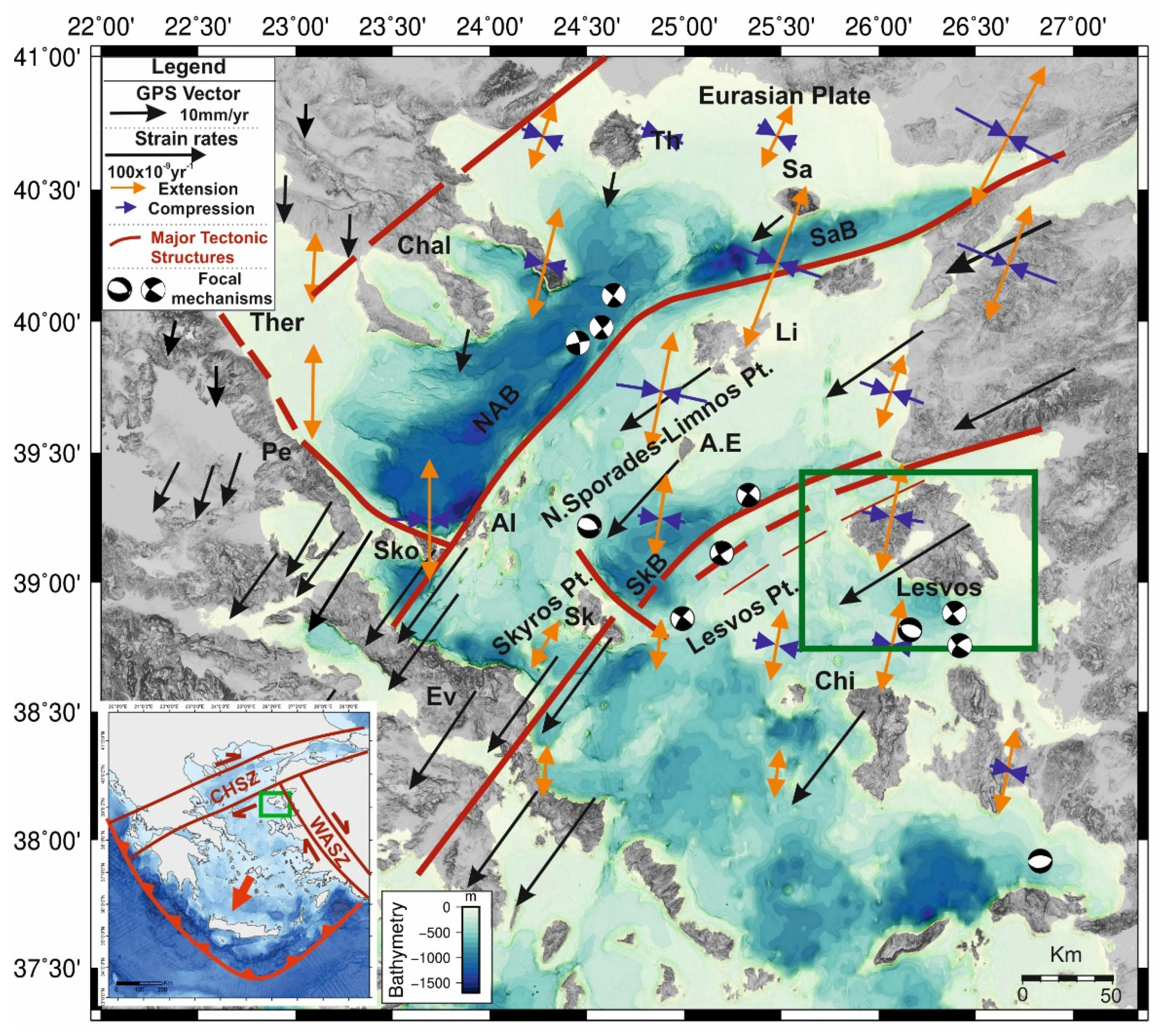

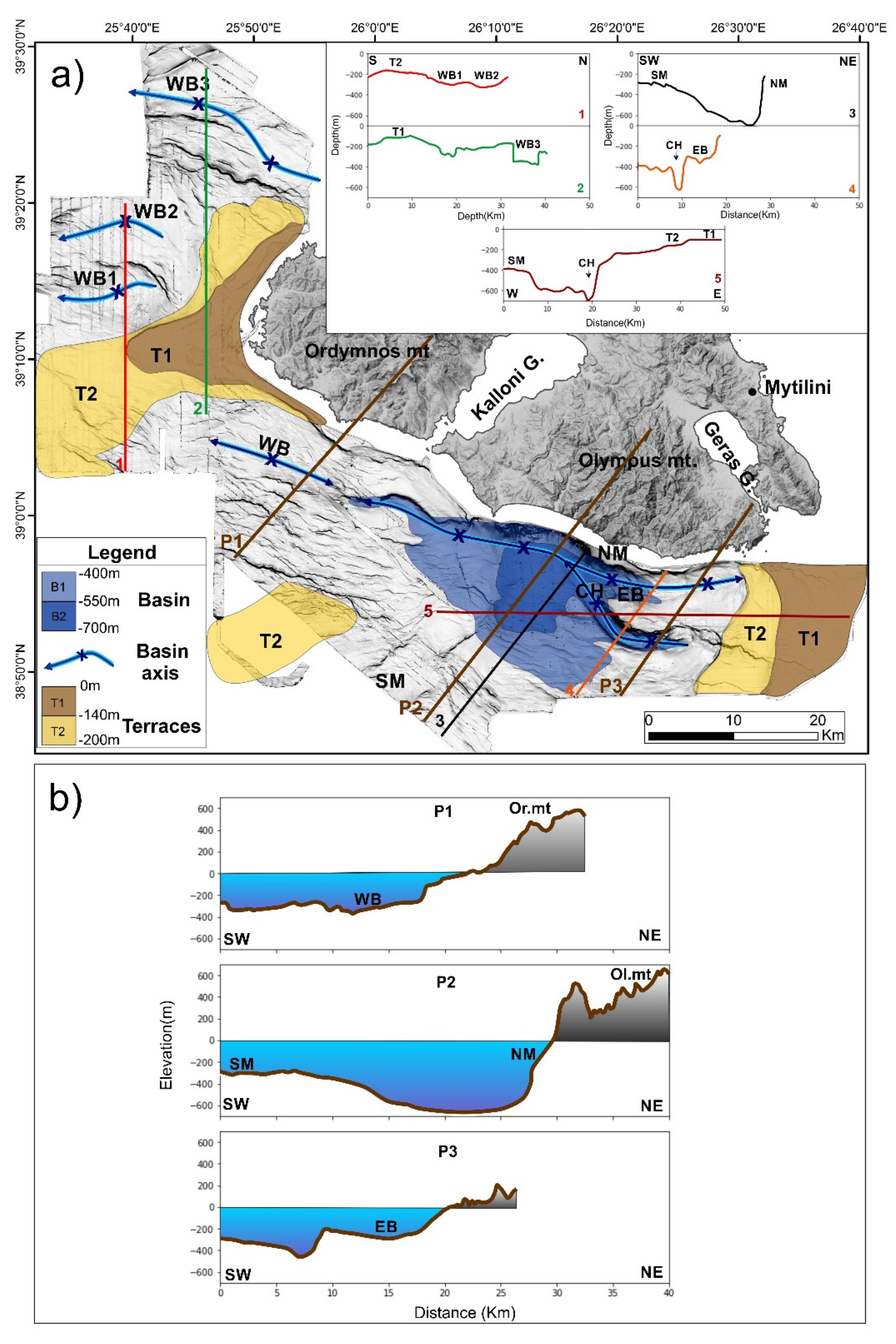

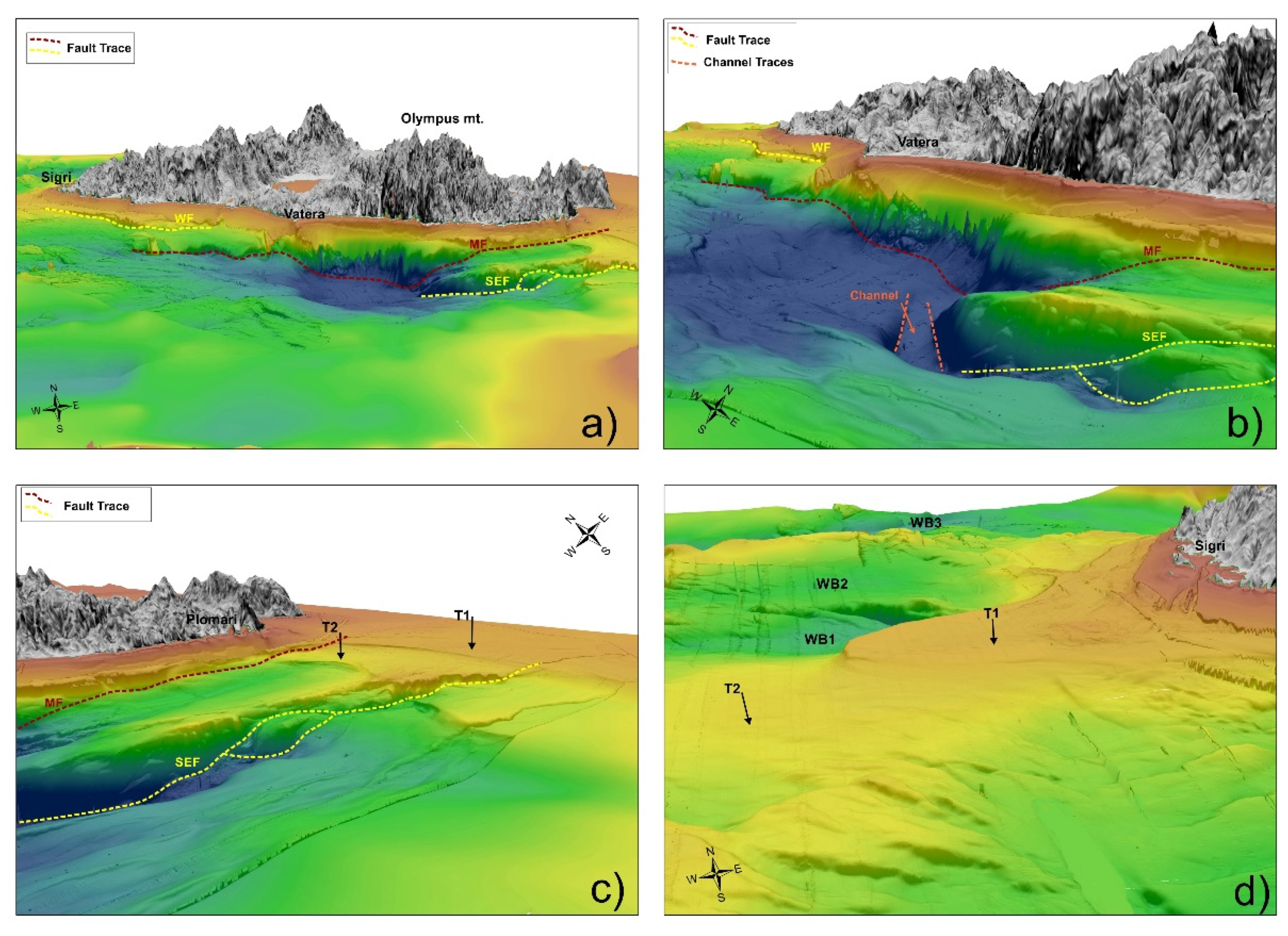
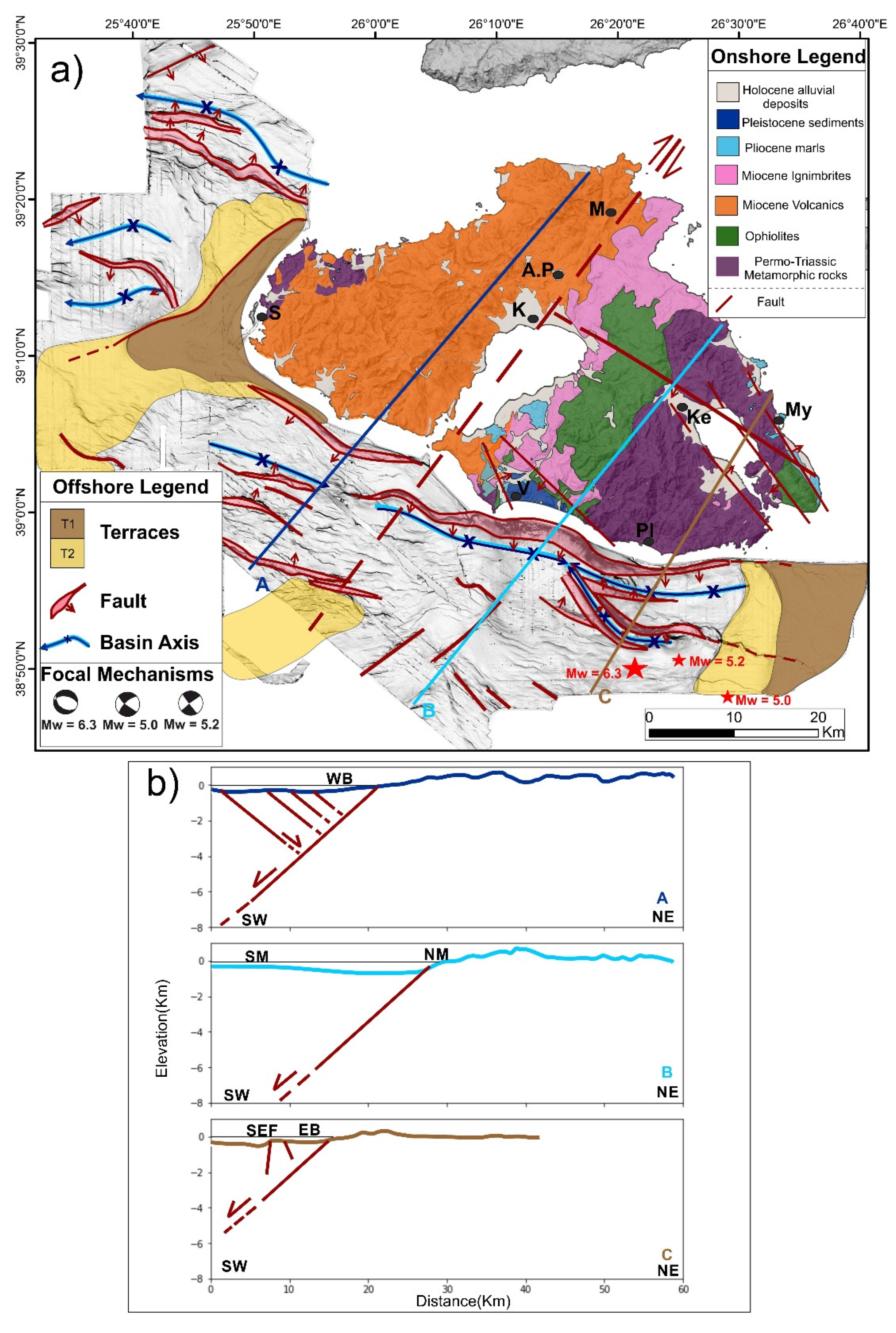
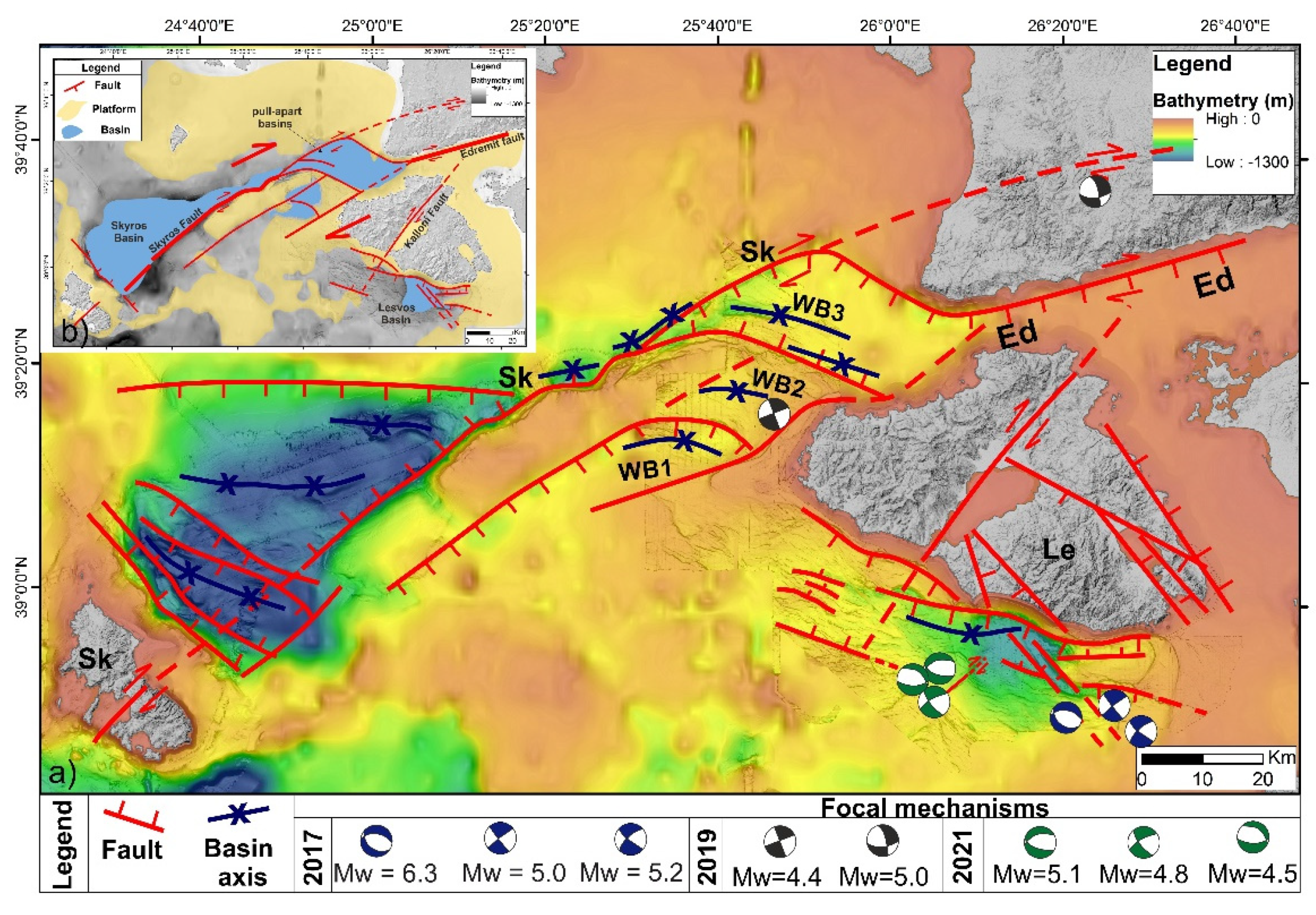
Publisher’s Note: MDPI stays neutral with regard to jurisdictional claims in published maps and institutional affiliations. |
© 2021 by the authors. Licensee MDPI, Basel, Switzerland. This article is an open access article distributed under the terms and conditions of the Creative Commons Attribution (CC BY) license (https://creativecommons.org/licenses/by/4.0/).
Share and Cite
Nomikou, P.; Evangelidis, D.; Papanikolaou, D.; Lampridou, D.; Litsas, D.; Tsaparas, Y.; Koliopanos, I.; Petroulia, M. Morphotectonic Structures along the Southwestern Margin of Lesvos Island, and Their Interrelation with the Southern Strand of the North Anatolian Fault, Aegean Sea, Greece. GeoHazards 2021, 2, 415-429. https://doi.org/10.3390/geohazards2040023
Nomikou P, Evangelidis D, Papanikolaou D, Lampridou D, Litsas D, Tsaparas Y, Koliopanos I, Petroulia M. Morphotectonic Structures along the Southwestern Margin of Lesvos Island, and Their Interrelation with the Southern Strand of the North Anatolian Fault, Aegean Sea, Greece. GeoHazards. 2021; 2(4):415-429. https://doi.org/10.3390/geohazards2040023
Chicago/Turabian StyleNomikou, Paraskevi, Dimitris Evangelidis, Dimitrios Papanikolaou, Danai Lampridou, Dimitris Litsas, Yannis Tsaparas, Ilias Koliopanos, and Maria Petroulia. 2021. "Morphotectonic Structures along the Southwestern Margin of Lesvos Island, and Their Interrelation with the Southern Strand of the North Anatolian Fault, Aegean Sea, Greece" GeoHazards 2, no. 4: 415-429. https://doi.org/10.3390/geohazards2040023
APA StyleNomikou, P., Evangelidis, D., Papanikolaou, D., Lampridou, D., Litsas, D., Tsaparas, Y., Koliopanos, I., & Petroulia, M. (2021). Morphotectonic Structures along the Southwestern Margin of Lesvos Island, and Their Interrelation with the Southern Strand of the North Anatolian Fault, Aegean Sea, Greece. GeoHazards, 2(4), 415-429. https://doi.org/10.3390/geohazards2040023







